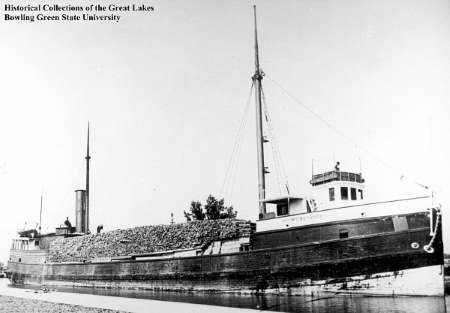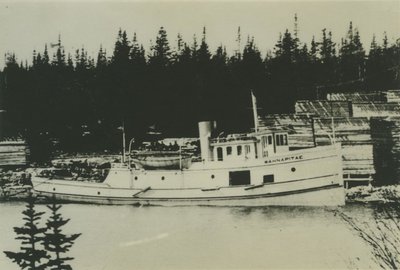Lumber Hookers and Tugs
on Georgian Bay
A lumber hooker named the W. L. Wetmore with a full load of lumber was built in 1871.
http://greatlakes.bgsu.edu/vessel/view/007571
Collection: HCGL/MAIN
Image ID: 005801
Lumber hookers and tugs were an
important innovation to improve the transportation of lumber on Georgian Bay. The importance of the Georgian Bay lumbering trade created a need to develop new technologies that were unique
to the timber industry.
Along with the many fleets of tugs which serviced the Georgian Bay maritime economy, the lumber hookers were designed to transport large amounts of forest products from remote sawmill locations to larger market areas for either immediate use or trans-shipment to points further into the interior of North America.
Lumber Hookers
The hookers were designed in a fashion similar to the bulk freighters which were beginning to appear on the Great Lakes. However, they were shorter and stubbier with raised after and fore-decks, with the pilot house at the front and the crew quarters in the aft section. The midsection was clear in order to carry large quantities of sawn lumber and logs.
These powerful vessels were also able to tow in their wake barges and rafts carrying more timber. It was not an uncommon sight to see a lumber hooker laden with sawlogs towing one or more schooners also loaded to capacity with sawlogs.
These floating lumber trains were also susceptible to the tyranny of the weather and sailing conditions of Georgian Bay.
On Nov. 29, 1901, the
lumber hooker W.L. Wetmore, with the schooners Brunette and James C. King in tow, was entering Devil Island Channel. With
heavy seas running out of the north-west accompanied by blinding snow, the W.L. Wetmore met its fate when it ran aground on Russel Reef
off Tobermory.
Diving The Wreck Of The Wetmore (1901), Tobermory, Canada
Tugs and the Forest Industry
Tugs were also important to the transportation of forest products. Fleets of tugs were maintained in Georgian Bay solely for the movement of timber. One of the most widely known tugs was the Wahnapitae. This craft was built by the Beck Lumber Company (other ship-building stories) in the winter of 1904-05. It was a two-masted, 191-ton vessel with a 300-horsepower engine. The Wahnapitae had a crew of nine men. In 1920 its length was increased from 90 to 120 feet. This powerful craft could tow booms containing 180,000 logs which was enough to keep sawn-mills operating non-stop for a month.
Photo Courtesy of Northeast Michigan Oral History and Historical Photograph Archive
http://www.nemoha.org/2897241/data
When the Beck Company's north shore timber limits became exhausted, the Wahnapitae was sold in
1929 to the Keenan Towing Company in Owen Sound. It towed barges, booms, and
pulpwood to the Keenan woodenware dock until it was sold in 1937 to the
McFadden Lumber Company of Blind River.
A tug towing a large raft of logs was vulnerable to the often-dangerous waters of Georgian Bay. In order to reduce the danger to the tugs and their crews, innovations were made to the manner in which these rafts were transported. A steam deck-winch was mounted at the stern of the tug. From this winch, a steel towing cable was extended to the raft. This cable maintained a distance of 600-700 feet between the raft and the tug. This distance was required to reduce the impact of the backwash created by the tug's propeller and therefore make the handling of the tug and its raft safer and more manageable for the crew.
As can be imagined, the stress created on the cable where it was hooked to the raft was intense. To reduce the possibility of the cable snapping, its connecting link with the raft, the point at which it was fastened to the raft was reinforced by bolting two oak blocks at the front of the raft. A hole was drilled through these blocks and the raft. A heavy steel chain was then looped through the hole and then connected to the end of the cable.
This connecting device was so strong that it was reported that it never gave out, even in a storm. An added feature of this system was that if a storm became so violent that the tug and its crew were in danger, the tug could separate itself from the raft simply by letting the steel cable run off the winch. Then, after the storm abated, the tug could return and find the raft, locate the towing cable, reattach it to the winch and continue on to its destination.
The lumber hookers and tugs that were so vital to the economy of the Georgian Bay area have long since
disappeared. Their role in the maritime history of the region is one that is
admired by anyone who has studied the development of the Georgian Bay region.
This Article originally appeared in my weekly column in the Owen Sound Sun Times.
Georgian Bay Shipping
List of Lighthouses on the Great Lakes: If you have names and/or pictures of Great Lakes Lighthouses please submit them along with details of their location.
Georgian Bay Ships: A List of all the ships that sailed on Georgian Bay until the 1960s. This list is not complete. If you know of a ship that sailed the waters of Georgian Bay please contact me with information about that vessel, and, if you have a picture that I could post with it, that would be much appreciated.
1885: A Memorable Summer Job for Owen Sound teenage boys on the Great Lakes would have historic importance, not mention a possible exciting career opportunity.
Hindman Transportation Company was a well-known Great Lakes shipping company for many years. Here you will find pictures of many of the Hindman ships
Owen Sound Harbour – A Photographic History, by Robert A. Cotton is a book that interests my historiographical curiosity.
Commercial Great Lakes Fishing It is probably safe to suggest that the commercial fishing industry was an important part of the early growth of this region.
A Georgian Bay fishing vacation has long been a popular attraction in the Bruce Peninsula region. During fishing derbies, the regional waterways are dotted with fishing boats of all shapes and sizes.
The Georgian Bay Mackinaw, designed by William Watts of Collingwood is an example of a Georgian Bay innovator creating a vessel to service the needs local mariners.
Great Lakes fishing is an asset that is protected and developed, not only for its economic potential but also for those who just enjoy spending a day by the side of a river or in small fishing boats trying to catch “the big one”!
Great Lakes Fishing History is not without its controversy. The impact of the fishing industry was such that it played an important role in the development of communities along the Georgian Bay and Lake Huron shoreline.
Georgian Bay Travel Before the Winter Freeze-Up could be a dangerous time for mariners in the early years in this region.
A Harbinger of Spring on the Great Lakes in pioneer times, was the eagerly awaited news that a lighthouse had been lit and shipping traffic could begin sailing from port to port.
Lumber Hookers Lumber hookers and tugs were an important innovation to improve the transportation of lumber on Georgian Bay.
Mapmakers on Georgian Bay were also explorers. They mapped the Georgina Bay shoreline noting safe harbours, dangerous reefs and other guides for sailors and pioneer settlers looking for a place to call home.
Paddling Georgian Bay & Pondering: traversing parts of this great waterway in a canoe leads one to wonder about the ships of a bygone era battling the rough seas they encountered.
Parry Sound Shipping History: The Parry Sound area has always been connected to the southern regions of the Province of Ontario by a system of good roads. Or has it?
Parry Sound’s shipping history 2 is more than the tragic sinking of the Waubuno or the later catastrophe surrounding the sinking of the Asia.
Sailing Season Closing: A Frantic Time on Peninsula as ships raced from port to port delivering and picking up passengers and produce before the waterways froze.
Ship Captain Andrew Port was not only a dynamic and brave Georgian Bay mariner, he was a personal favourite historical character of mine.
Ships Stuck in Ice: The Oak Glen was icebound in 1996 but this sailing hazard has been impacting vessels on Georgian Bay since the beginning of time.
Lake Huron shipwrecks, the Hibou often occurred in the Georgian Bay region of that Great Lake due to the often violent waters that could strike unsuspecting vessels like the Hibou.
Shipwrecks: The "Asia" wrecked off the eastern coast of Georgian Bay taking all but two of the more than 100 passengers to a watery grave.
Masters, Mates, and Pilots Association created its first Canadian chapter on Georgian Bay, providing maritime safety education, and other seafaring issues to better inform its membership.
Pioneer Travel Aboard the Fly Tells the story of a sailing vessel as the tenuous link between survival and death in a pioneer settlement in the 1840's in Upper Canada.
Sailing Stories: the Captain Who Smelled his way into Port The Captain Who Smelled his Way into Port details how pioneer seamen on Georgian Bay safely sailed the rough waters without the aid of the modern technological tools so readily used by today's mariners.
Sailing Story: The Voyage of the Prince Alfred the incredible voyage of the Prince Alfred, fraught with danger for both vessel and the crew in the winter of 1880.
Shipbuilding As the southern Georgian Bay region became more populated shipping traffic increased to meet the needs of an expanding market place.
The Summer of 1844 was No Picnic for the early settlers in the pioneer area near what would become Owen Sound on Georgian Bay.
The CPR Grain Elevator Fire of 1911 spelled the end of Owen Sound's role as the eastern terminus of the CPR Great Lakes Fleet.
Georgian Bay shipping occurred long before the first Europeans paddled these waters. But the fur and timber trades opened Georgian Bay to shipping in a big way!







